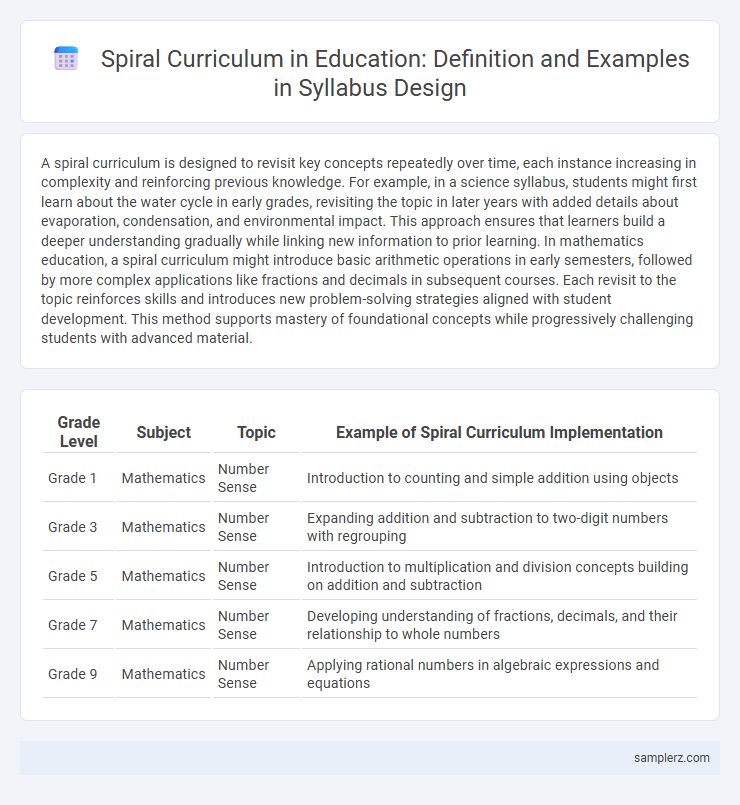A spiral curriculum is designed to revisit key concepts repeatedly over time, each instance increasing in complexity and reinforcing previous knowledge. For example, in a science syllabus, students might first learn about the water cycle in early grades, revisiting the topic in later years with added details about evaporation, condensation, and environmental impact. This approach ensures that learners build a deeper understanding gradually while linking new information to prior learning. In mathematics education, a spiral curriculum might introduce basic arithmetic operations in early semesters, followed by more complex applications like fractions and decimals in subsequent courses. Each revisit to the topic reinforces skills and introduces new problem-solving strategies aligned with student development. This method supports mastery of foundational concepts while progressively challenging students with advanced material.
Table of Comparison
| Grade Level | Subject | Topic | Example of Spiral Curriculum Implementation |
|---|---|---|---|
| Grade 1 | Mathematics | Number Sense | Introduction to counting and simple addition using objects |
| Grade 3 | Mathematics | Number Sense | Expanding addition and subtraction to two-digit numbers with regrouping |
| Grade 5 | Mathematics | Number Sense | Introduction to multiplication and division concepts building on addition and subtraction |
| Grade 7 | Mathematics | Number Sense | Developing understanding of fractions, decimals, and their relationship to whole numbers |
| Grade 9 | Mathematics | Number Sense | Applying rational numbers in algebraic expressions and equations |
Understanding the Spiral Curriculum Approach
The spiral curriculum approach involves revisiting key concepts repeatedly over time, with increasing complexity to deepen student understanding and retention. In a science syllabus, this might include introducing basic ecosystems in early grades, then progressively exploring energy flow, biodiversity, and human impact on environments in later years. This structured repetition ensures learners build on prior knowledge, making connections and mastering content progressively.
Key Features of a Spiral Curriculum
A spiral curriculum revisits key concepts repeatedly, increasing in complexity with each iteration to reinforce learning and deepen understanding. Core principles include systematic revisiting of topics, progressive development of skills, and integration of prior knowledge to build cognitive connections. This approach enhances long-term retention and supports mastery through continuous reinforcement within the syllabus structure.
Spiral Curriculum in Mathematics: A Grade-Level Example
The spiral curriculum in mathematics revisits key concepts such as fractions, decimals, and basic algebra across grade levels, gradually increasing in complexity from Grade 3 to Grade 7. For instance, students begin by recognizing simple fractions in Grade 3, move to comparing and ordering fractions in Grade 5, and progress to solving equations involving fractions by Grade 7. This approach reinforces understanding and retention by building on prior knowledge while introducing new skills aligned with developmental readiness.
Integrating Spiral Learning in Science Syllabi
Integrating spiral learning in science syllabi involves revisiting core concepts such as photosynthesis, matter states, and energy cycles at increasing levels of complexity throughout the academic year. This method enhances cognitive retention by progressively building on prior knowledge, ensuring foundational principles are reinforced while introducing advanced scientific phenomena. Effective spiral curriculum design aligns topics like cellular biology and chemical reactions with age-appropriate depth, promoting continuous skill development and conceptual understanding.
Language Arts: Spiral Curriculum Syllabus Design
The spiral curriculum in Language Arts syllabus design revisits key concepts such as phonics, vocabulary, reading comprehension, and writing skills across grade levels with increasing complexity and depth. For instance, early grades focus on foundational phonemic awareness and simple sentence structures, while later grades expand to nuanced literary analysis and advanced writing techniques. This iterative approach reinforces learning and enhances mastery through repeated exposure and progressive challenges in language acquisition.
History Teaching with a Spiral Curriculum Model
In History teaching using a Spiral Curriculum Model, key historical events such as the Industrial Revolution, World Wars, and the Civil Rights Movement are revisited at increasing levels of complexity throughout the syllabus. Each revisit deepens students' understanding by integrating cause-effect relationships, socio-economic factors, and cultural impacts with greater analytical skills. This approach enhances retention and critical thinking by connecting prior knowledge with new insights in a structured, iterative learning process.
Spiral Curriculum Examples in Primary Education
The Singapore Math syllabus exemplifies a spiral curriculum by revisiting key mathematical concepts such as addition, subtraction, and basic geometry across multiple grade levels with increasing complexity. The science curriculum in primary education often reintroduces topics like plant life cycles and weather patterns, deepening students' understanding through progressively detailed lessons. Language arts programs spiral skills in reading comprehension and vocabulary by revisiting texts and themes, allowing learners to build higher-level literacy abilities year after year.
Applying the Spiral Approach to Secondary School Syllabi
The spiral curriculum in secondary school syllabi revisits key concepts such as algebraic functions in progressively complex ways across grade levels, reinforcing understanding through repeated exposure and application. Science courses often incorporate the spiral approach by reintroducing foundational principles like the periodic table and chemical reactions with increasing depth and practical experiments. This method enhances retention and critical thinking by building on prior knowledge while aligning with cognitive development stages in adolescent learners.
Comparing Spiral vs. Traditional Curriculum Structures
The spiral curriculum revisits key concepts repeatedly with increasing complexity, enhancing long-term retention and deeper understanding, as opposed to the traditional curriculum which often follows a linear, one-time coverage approach. Research indicates that students in spiral curriculum structures demonstrate improved problem-solving skills and adaptability due to iterative exposure and reinforcement. Implementing spiral curriculum in syllabus design facilitates cumulative learning and supports diverse learning paces, contrasting with the segmented and compartmentalized nature of traditional models.
Assessing Student Progress in a Spiral Curriculum
Assessing student progress in a spiral curriculum involves revisiting core concepts with increasing complexity, enabling educators to measure growth over time. Tools such as formative assessments, quizzes, and reflective journals provide continuous feedback aligned with each iteration of the topic. This approach ensures mastery and reinforces learning by connecting new information with prior knowledge.

example of spiral curriculum in syllabus Infographic
 samplerz.com
samplerz.com